Saying goodbye to a seasonal property is an annual ritual for Americans who own unwinterized vacation homes.
There are so many tasks to remember, but they’re all vitally important: Falling temperatures can wreak havoc on plumbing, so pipes must be drained. Mattresses and bedding have to be protected or they’ll make cozy nests for critters. Kitchenware needs to be packed up tight, away from insects and dust, and appliances unplugged to guard against lightning strikes.
Some of these preparations require a plumber’s know-how, but most are straightforward. “It takes about a day,” says Sharon Halverson, who has been shutting down her lakeside cabin in central Minnesota for nearly 35 years. “But once we’re done, we set the alarm, and that’s the end of it.”
At least until the sun warms and the clear lake waters call vacationers back next year.
Winterize Your Plumbing System in Your Vacation Home
One of the most critical aspects of closing a vacation home is protecting the plumbing system from freezing temperatures. To prevent pipes from bursting due to frozen water, you need to drain them. Follow these steps:
- Shut off the main water supply.
- Open all faucets and flush toilets to drain water from the pipes.
- Use an air compressor to blow out any remaining water in the lines.
- Pour non-toxic antifreeze into toilet bowls and sink traps.
Don’t forget about your water heater and other fixtures, too. Drain and unplug the water heater, and insulate exposed pipes with foam sleeves. Disconnect and drain outdoor hoses and sprinkler systems.
Heating and Electrical Utilities
Switch off the main electrical breaker, leaving only essential circuits active. Consider installing a whole-house surge protector for added protection.
Set the thermostat to a low temperature (around 55 degrees Fahrenheit) to prevent freezing, and close the fireplace flue to keep out animals and drafts.
Shut off the gas supply if you’ll be away for an extended period.
Secure Your Vacation Home’s Exterior
Prepare your yard and outdoor areas for the winter by mowing the lawn one final time and raking leaves. Store lawn equipment and tools in a locked shed or garage.
Cover or store patio furniture to prevent weather damage, and remove hanging plants and empty planters to avoid cracking.
Secure all entry points to your home, inspecting and repairing any damaged window or door seals and installing storm windows and doors if needed.
Use deadbolts on all exterior doors, and consider adding window locks or security film for extra protection. You may also want to install motion-sensor lights around the perimeter or use timed lighting indoors to give the appearance of occupancy.
Check that any security alarms or systems are functioning correctly, and consider investing in window and door alarm sensors.
Safeguard the Interior of Your Home
Cover furniture with sheets to protect them from dust, and store valuables in a safe or remove them from the property.
Seal any cracks or holes in the foundation and walls to keep out critters, and place mothballs in closets and drawers to deter insects. Set mouse traps in strategic locations, and consider hiring a pest control service for professional prevention.
To prevent fire damage, ensure that smoke and carbon monoxide detectors are functional. Remove any flammable materials from the home, unplug unnecessary electrical devices, and clean chimney areas.
Preparing Pantry and Fridge Items
Preparing perishables and pantry items adequately can prevent nasty surprises when you return. Focus on removing pantry items that might attract pests while you’re gone.
- Dispose of open and perishable items.
- Store unopened non-perishables in plastic bins or containers.
- Remove any garbage or recycling that may contain food scraps.
- Wipe down the shelving and vacuum the pantry area to eliminate food crumbs.
Your fridge and freezer should be cleaned and managed to avoid unpleasant odors or mold growth. Consume or dispose of all perishable goods, and defrost the freezer if necessary. Thoroughly clean both the refrigerator and freezer compartments and leave appliance doors slightly ajar to prevent mildew and odors.
Create a Neighbor Network To Monitor Your Vacation Home
Having a trusted local contact can be invaluable in managing your vacation home while you’re away. Establishing a network within the community adds another layer of protection. Get to know your neighbors and establish a rapport. This can provide additional oversight and help in emergencies.
Exchange contact information with neighbors, and provide key details to a trusted neighbor or property manager. Ask neighbors to check on your home periodically while you’re away.
Emergency Contact Sheet
Leave an emergency contact sheet readily available at your vacation home. Include your contact information and that of a property manager. List contact numbers for local services like the police, fire department, and utility companies, and provide contact details for any home service providers.
Closure Checklist for Your Vacation Home
Develop a comprehensive checklist so that you don’t overlook any important tasks. Before you hit the lights and turn the key in the lock for the last time, make sure you’ve taken care of these house-protecting tasks:
- Shut off the water.
- Unplug all appliances—especially the television—and telephones in case of a lightning strike.
- Turn off all circuit breakers except the ones for alarms.
- Turn off the gas supply.
- Empty the refrigerator and cupboards: Food can attract animals, and canned goods can explode if they freeze.
- Put away outdoor furniture, grills, and other accessories, including garbage cans.
- Lock shed and garage doors.
- Hang a few strips of flypaper.
- Lock all windows and doors.
- Take the last load of garbage to the dump.

